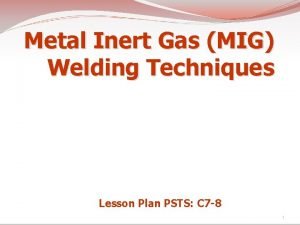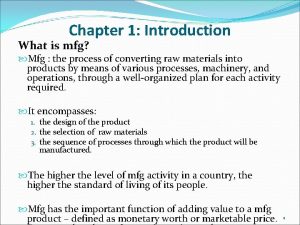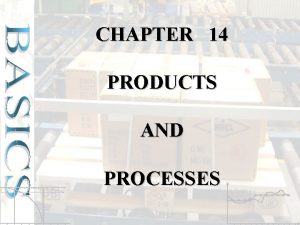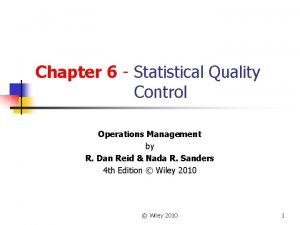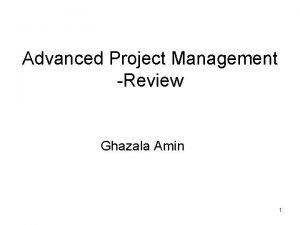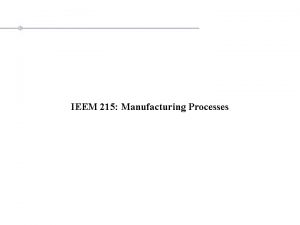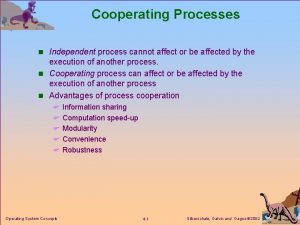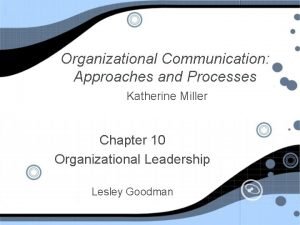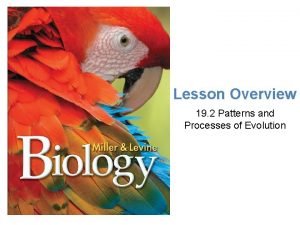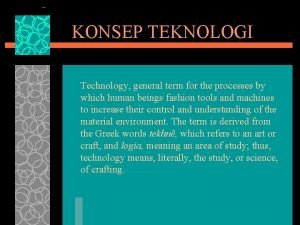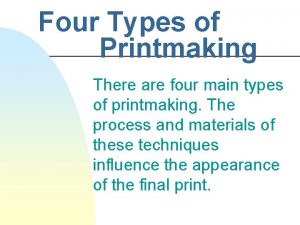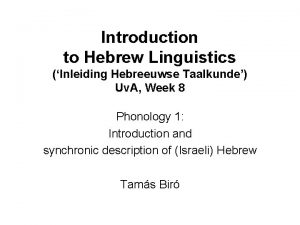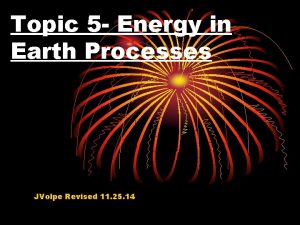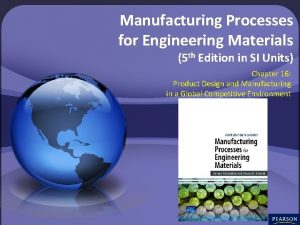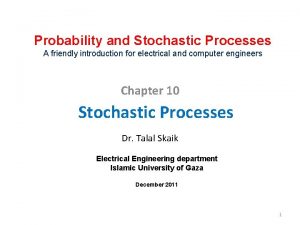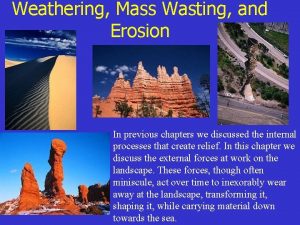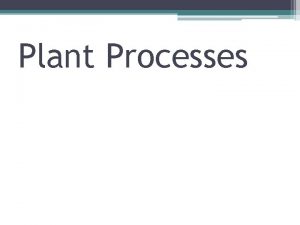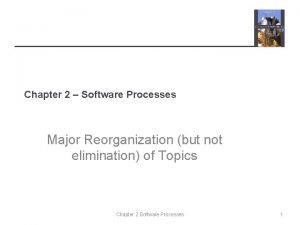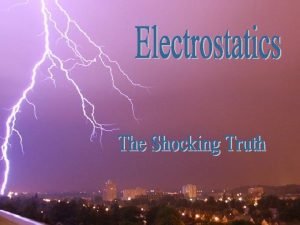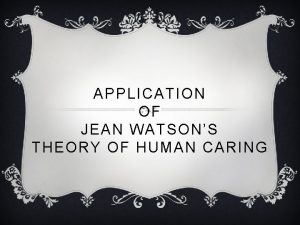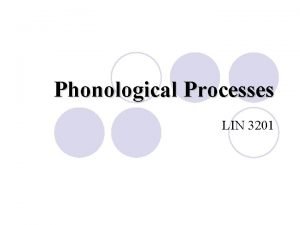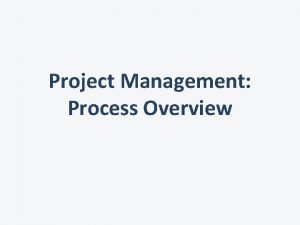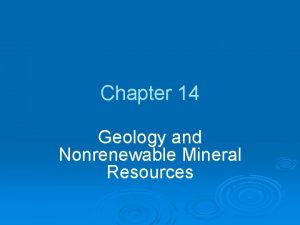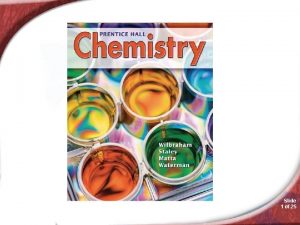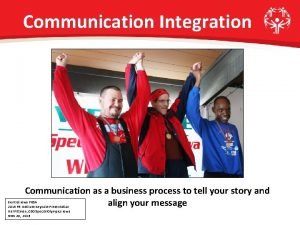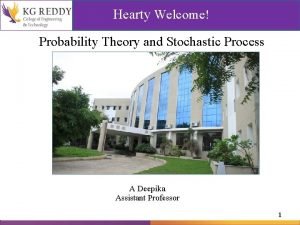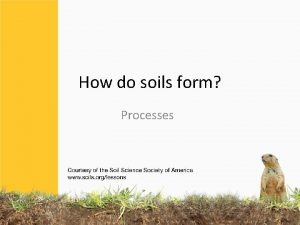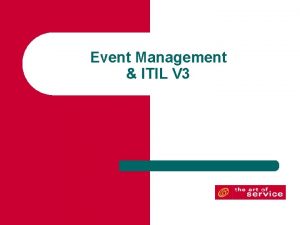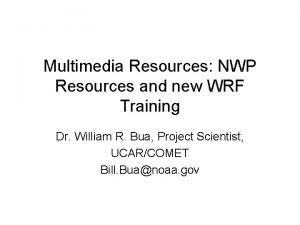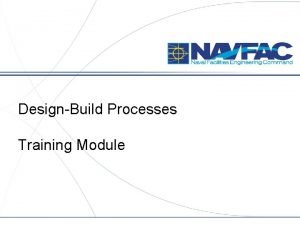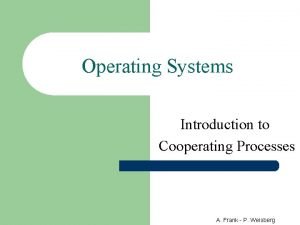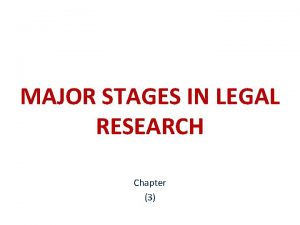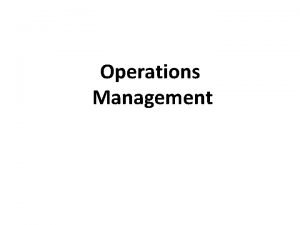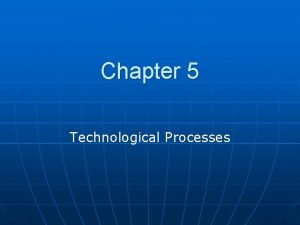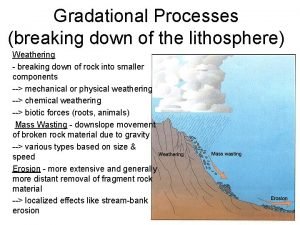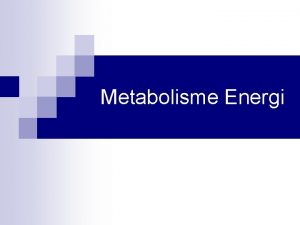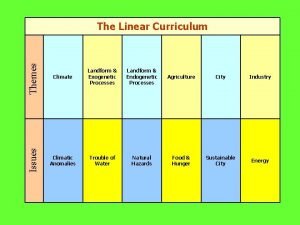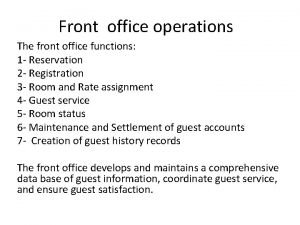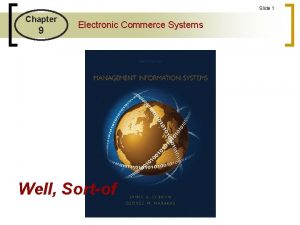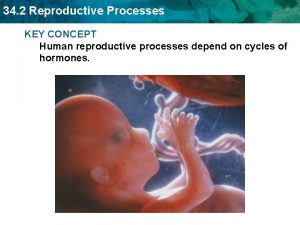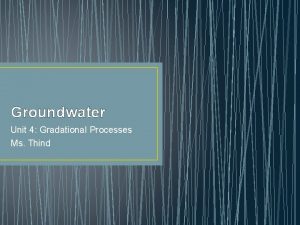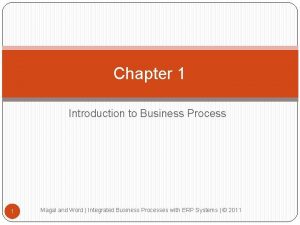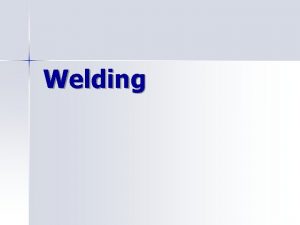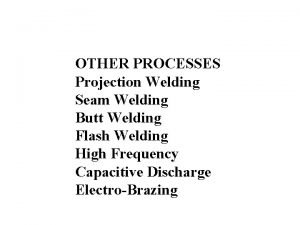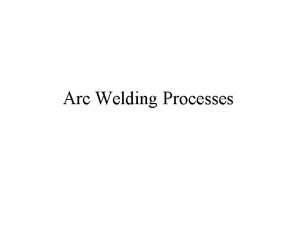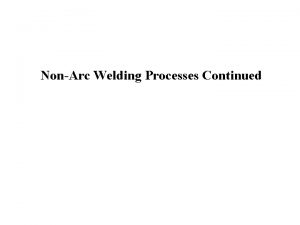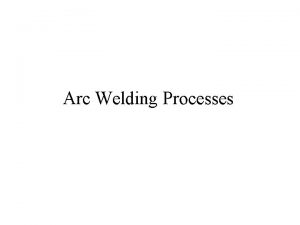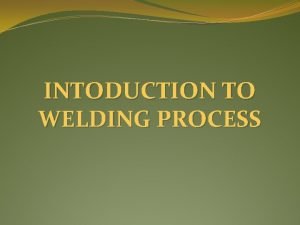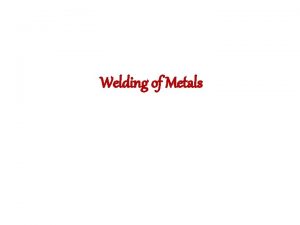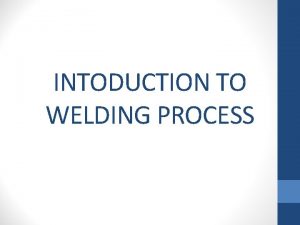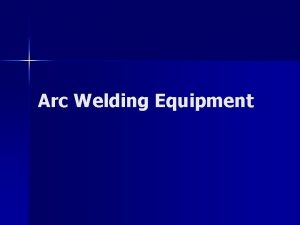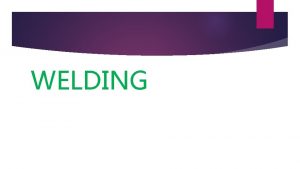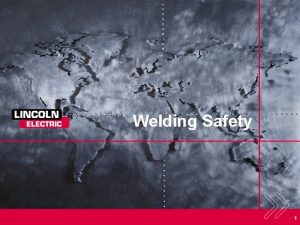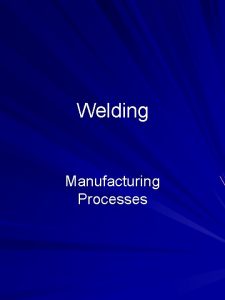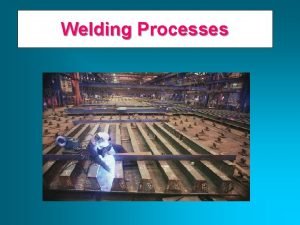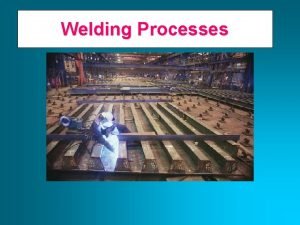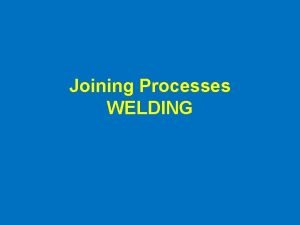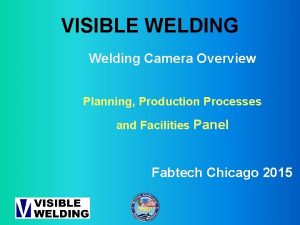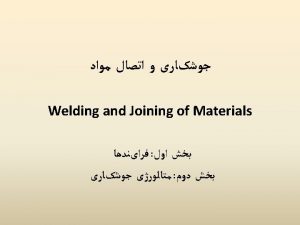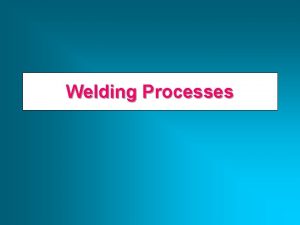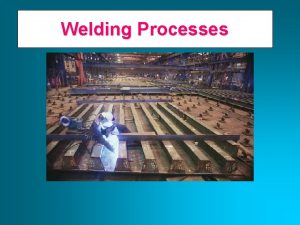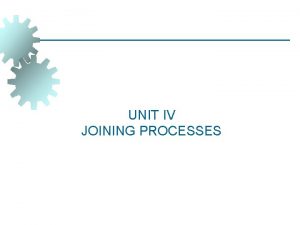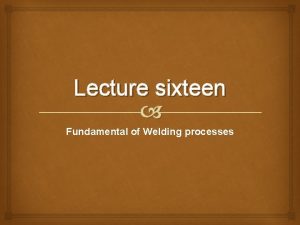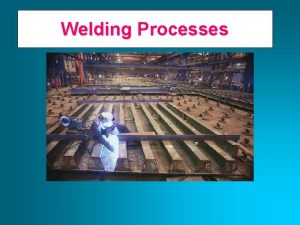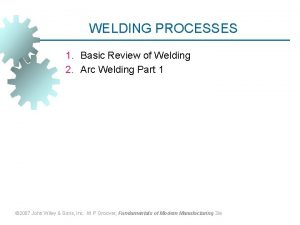WELDING PROCESSES 1 2 3 4 5 6





























































- Slides: 61

WELDING PROCESSES 1. 2. 3. 4. 5. 6. 7. 8. Arc Welding Resistance Welding Oxyfuel Gas Welding Other Fusion Welding Processes Solid State Welding Weld Quality Weldability Design Considerations in Welding © 2010 John Wiley & Sons, Inc. M P Groover, Fundamentals of Modern Manufacturing 4/e

Two Categories of Welding Processes § Fusion welding - coalescence is accomplished by melting the two parts to be joined, in some cases adding filler metal to the joint § Examples: arc welding, resistance spot welding, oxyfuel gas welding § Solid state welding - heat and/or pressure are used to achieve coalescence, but no melting of base metals occurs and no filler metal is added § Examples: forge welding, diffusion welding, friction welding © 2010 John Wiley & Sons, Inc. M P Groover, Fundamentals of Modern Manufacturing 4/e

Arc Welding (AW) A fusion welding process in which coalescence of the metals is achieved by the heat from an electric arc between an electrode and the work § Electric energy from the arc produces temperatures ~ 10, 000 F (5500 C), hot enough to melt any metal § Most AW processes add filler metal to increase volume and strength of weld joint © 2010 John Wiley & Sons, Inc. M P Groover, Fundamentals of Modern Manufacturing 4/e

What is an Electric Arc? An electric arc is a discharge of electric current across a gap in a circuit § It is sustained by an ionized column of gas (plasma) through which the current flows § To initiate the arc in AW, electrode is brought into contact with work and then quickly separated from it by a short distance © 2010 John Wiley & Sons, Inc. M P Groover, Fundamentals of Modern Manufacturing 4/e

Arc Welding § A pool of molten metal is formed near electrode tip, and as electrode is moved along joint, molten weld pool solidifies in its wake © 2010 John Wiley & Sons, Inc. M P Groover, Fundamentals of Modern Manufacturing 4/e

Manual Arc Welding and Arc Time § Problems with manual welding: § Weld joint quality § Productivity § Arc Time = (time arc is on) divided by (hours worked) § Also called “arc-on time” § Manual welding arc time = 20% § Machine welding arc time ~ 50% © 2010 John Wiley & Sons, Inc. M P Groover, Fundamentals of Modern Manufacturing 4/e

Two Basic Types of AW Electrodes § Consumable – consumed during welding process § Source of filler metal in arc welding § Nonconsumable – not consumed during welding process § Filler metal must be added separately if it is added © 2010 John Wiley & Sons, Inc. M P Groover, Fundamentals of Modern Manufacturing 4/e

Consumable Electrodes § Forms of consumable electrodes § Welding rods (a. k. a. sticks) are 9 to 18 inches and 3/8 inch or less in diameter and must be changed frequently § Weld wire can be continuously fed from spools with long lengths of wire, avoiding frequent interruptions § In both rod and wire forms, electrode is consumed by the arc and added to weld joint as filler metal © 2010 John Wiley & Sons, Inc. M P Groover, Fundamentals of Modern Manufacturing 4/e

Nonconsumable Electrodes § Made of tungsten which resists melting § Gradually depleted during welding (vaporization is principal mechanism) § Any filler metal must be supplied by a separate wire fed into weld pool © 2010 John Wiley & Sons, Inc. M P Groover, Fundamentals of Modern Manufacturing 4/e

Arc Shielding § At high temperatures in AW, metals are chemically reactive to oxygen, nitrogen, and hydrogen in air § Mechanical properties of joint can be degraded by these reactions § To protect operation, arc must be shielded from surrounding air in AW processes § Arc shielding is accomplished by: § Shielding gases, e. g. , argon, helium, CO 2 § Flux © 2010 John Wiley & Sons, Inc. M P Groover, Fundamentals of Modern Manufacturing 4/e

Flux A substance that prevents formation of oxides and other contaminants in welding, or dissolves them and facilitates removal § Provides protective atmosphere for welding § Stabilizes arc § Reduces spattering © 2010 John Wiley & Sons, Inc. M P Groover, Fundamentals of Modern Manufacturing 4/e

Various Flux Application Methods § Pouring granular flux onto welding operation § Stick electrode coated with flux material that melts during welding to cover operation § Tubular electrodes in which flux is contained in the core and released as electrode is consumed © 2010 John Wiley & Sons, Inc. M P Groover, Fundamentals of Modern Manufacturing 4/e

Power Source in Arc Welding § Direct current (DC) vs. Alternating current (AC) § AC machines less expensive to purchase and operate, but generally restricted to ferrous metals § DC equipment can be used on all metals and is generally noted for better arc control © 2010 John Wiley & Sons, Inc. M P Groover, Fundamentals of Modern Manufacturing 4/e

Consumable Electrode AW Processes § § § Shielded Metal Arc Welding Gas Metal Arc Welding Flux‑Cored Arc Welding Electrogas Welding Submerged Arc Welding © 2010 John Wiley & Sons, Inc. M P Groover, Fundamentals of Modern Manufacturing 4/e

Shielded Metal Arc Welding (SMAW) Uses a consumable electrode consisting of a filler metal rod coated with chemicals that provide flux and shielding § Sometimes called "stick welding" § Power supply, connecting cables, and electrode holder available for a few thousand dollars © 2010 John Wiley & Sons, Inc. M P Groover, Fundamentals of Modern Manufacturing 4/e

Shielded Metal Arc Welding (SMAW) © 2010 John Wiley & Sons, Inc. M P Groover, Fundamentals of Modern Manufacturing 4/e

Welding Stick in SMAW § Composition of filler metal usually close to base metal § Coating: powdered cellulose mixed with oxides and carbonates, and held together by a silicate binder § Welding stick is clamped in electrode holder connected to power source § Disadvantages of stick welding: § Sticks must be periodically changed § High current levels may melt coating prematurely © 2010 John Wiley & Sons, Inc. M P Groover, Fundamentals of Modern Manufacturing 4/e

Shielded Metal Arc Welding § Shielded metal arc welding (stick welding) performed by a human welder (photo courtesy of Hobart Brothers Co. ) © 2010 John Wiley & Sons, Inc. M P Groover, Fundamentals of Modern Manufacturing 4/e

SMAW Applications § Used for steels, stainless steels, cast irons, and certain nonferrous alloys § Not used or rarely used for aluminum and its alloys, copper alloys, and titanium © 2010 John Wiley & Sons, Inc. M P Groover, Fundamentals of Modern Manufacturing 4/e

Gas Metal Arc Welding (GMAW) Uses a consumable bare metal wire as electrode with shielding by flooding arc with a gas § Wire is fed continuously and automatically from a spool through the welding gun § Shielding gases include argon and helium for aluminum welding, and CO 2 for steel welding § Bare electrode wire plus shielding gases eliminate slag on weld bead § No need for manual grinding and cleaning of slag © 2010 John Wiley & Sons, Inc. M P Groover, Fundamentals of Modern Manufacturing 4/e

Gas Metal Arc Welding © 2010 John Wiley & Sons, Inc. M P Groover, Fundamentals of Modern Manufacturing 4/e

GMAW Advantages over SMAW § Better arc time because of continuous wire electrode § Sticks must be periodically changed in SMAW § Better use of electrode filler metal than SMAW § End of stick cannot be used in SMAW § Higher deposition rates § Eliminates problem of slag removal § Can be readily automated © 2010 John Wiley & Sons, Inc. M P Groover, Fundamentals of Modern Manufacturing 4/e

Flux‑Cored Arc Welding (FCAW) Adaptation of shielded metal arc welding, to overcome limitations of stick electrodes - two versions § Self‑shielded FCAW - core includes compounds that produce shielding gases § Gas‑shielded FCAW - uses externally applied shielding gases § Electrode is a continuous consumable tubing (in coils) containing flux and other ingredients (e. g. , alloying elements) in its core © 2010 John Wiley & Sons, Inc. M P Groover, Fundamentals of Modern Manufacturing 4/e

Flux-Cored Arc Welding Presence or absence of externally supplied shielding gas distinguishes: (1) self‑shielded - core provides ingredients for shielding, (2) gas‑shielded - uses external shielding gases © 2010 John Wiley & Sons, Inc. M P Groover, Fundamentals of Modern Manufacturing 4/e

Electrogas Welding (EGW) Uses a continuous consumable electrode, flux‑cored wire or bare with externally supplied shielding gases, and molding shoes to contain molten metal § When flux‑cored electrode wire is used and no external gases are supplied, then special case of self‑shielded FCAW § When a bare electrode wire used with shielding gases from external source, then special case of GMAW © 2010 John Wiley & Sons, Inc. M P Groover, Fundamentals of Modern Manufacturing 4/e

Electrogas Welding § Electrogas welding using flux‑cored electrode wire: (a) front view with molding shoe removed for clarity, and (b) side view showing molding shoes on both sides © 2010 John Wiley & Sons, Inc. M P Groover, Fundamentals of Modern Manufacturing 4/e

Submerged Arc Welding (SAW) Uses a continuous, consumable bare wire electrode, with arc shielding by a cover of granular flux § Electrode wire is fed automatically from a coil § Flux introduced into joint slightly ahead of arc by gravity from a hopper § Completely submerges operation, preventing sparks, spatter, and radiation © 2010 John Wiley & Sons, Inc. M P Groover, Fundamentals of Modern Manufacturing 4/e

Submerged Arc Welding © 2010 John Wiley & Sons, Inc. M P Groover, Fundamentals of Modern Manufacturing 4/e

SAW Applications and Products § Steel fabrication of structural shapes (e. g. , I‑beams) § Seams for large diameter pipes, tanks, and pressure vessels § Welded components for heavy machinery § Most steels (except hi C steel) § Not good for nonferrous metals © 2010 John Wiley & Sons, Inc. M P Groover, Fundamentals of Modern Manufacturing 4/e

Nonconsumable Electrode Processes § § Gas Tungsten Arc Welding Plasma Arc Welding Carbon Arc Welding Stud Welding © 2010 John Wiley & Sons, Inc. M P Groover, Fundamentals of Modern Manufacturing 4/e

Gas Tungsten Arc Welding (GTAW) Uses a nonconsumable tungsten electrode and an inert gas for arc shielding § Melting point of tungsten = 3410 C (6170 F) § A. k. a. Tungsten Inert Gas (TIG) welding § In Europe, called "WIG welding" § Used with or without a filler metal § When filler metal used, it is added to weld pool from separate rod or wire § Applications: aluminum and stainless steel mostly © 2010 John Wiley & Sons, Inc. M P Groover, Fundamentals of Modern Manufacturing 4/e

Gas Tungsten Arc Welding © 2010 John Wiley & Sons, Inc. M P Groover, Fundamentals of Modern Manufacturing 4/e

Advantages and Disadvantages of GTAW Advantages: § High quality welds for suitable applications § No spatter because no filler metal through arc § Little or no post-weld cleaning because no flux Disadvantages: § Generally slower and more costly than consumable electrode AW processes © 2010 John Wiley & Sons, Inc. M P Groover, Fundamentals of Modern Manufacturing 4/e

Plasma Arc Welding (PAW) Special form of GTAW in which a constricted plasma arc is directed at weld area § Tungsten electrode is contained in a nozzle that focuses a high velocity stream of inert gas (argon) into arc region to form a high velocity, intensely hot plasma arc stream § Temperatures in PAW reach 28, 000 C (50, 000 F), due to constriction of arc, producing a plasma jet of small diameter and very high energy density © 2010 John Wiley & Sons, Inc. M P Groover, Fundamentals of Modern Manufacturing 4/e

Plasma Arc Welding © 2010 John Wiley & Sons, Inc. M P Groover, Fundamentals of Modern Manufacturing 4/e

Advantages and Disadvantages of PAW Advantages: § Good arc stability and excellent weld quality § Better penetration control than other AW processes § High travel speeds § Can be used to weld almost any metals Disadvantages: § High equipment cost § Larger torch size than other AW processes § Tends to restrict access in some joints © 2010 John Wiley & Sons, Inc. M P Groover, Fundamentals of Modern Manufacturing 4/e

Resistance Welding (RW) A group of fusion welding processes that use a combination of heat and pressure to accomplish coalescence § Heat generated by electrical resistance to current flow at junction to be welded § Principal RW process is resistance spot welding (RSW) © 2010 John Wiley & Sons, Inc. M P Groover, Fundamentals of Modern Manufacturing 4/e

Resistance Welding § Resistance welding, showing components in spot welding, the main process in the RW group © 2010 John Wiley & Sons, Inc. M P Groover, Fundamentals of Modern Manufacturing 4/e

Components in Resistance Spot Welding § Parts to be welded (usually sheet metal) § Two opposing electrodes § Means of applying pressure to squeeze parts between electrodes § Power supply from which a controlled current can be applied for a specified time duration © 2010 John Wiley & Sons, Inc. M P Groover, Fundamentals of Modern Manufacturing 4/e

Advantages and Drawbacks of Resistance Welding Advantages: § No filler metal required § High production rates possible § Lends itself to mechanization and automation § Lower operator skill level than for arc welding § Good repeatability and reliability Disadvantages: § High initial equipment cost § Limited to lap joints for most RW processes © 2010 John Wiley & Sons, Inc. M P Groover, Fundamentals of Modern Manufacturing 4/e

Resistance Spot Welding (RSW) Resistance welding process in which fusion of faying surfaces of a lap joint is achieved at one location by opposing electrodes § Used to join sheet metal parts § Widely used in mass production of automobiles, metal furniture, appliances, and other sheet metal products § Typical car body has ~ 10, 000 spot welds § Annual production of automobiles in the world is measured in tens of millions of units © 2010 John Wiley & Sons, Inc. M P Groover, Fundamentals of Modern Manufacturing 4/e

Spot Welding Cycle § (a) Spot welding cycle § (b) Plot of force and current § Cycle: (1) parts inserted between electrodes, (2) electrodes close, (3) current on, (4) current off, (5) electrodes opened © 2010 John Wiley & Sons, Inc. M P Groover, Fundamentals of Modern Manufacturing 4/e

Resistance Seam Welding (RSEW) Uses rotating wheel electrodes to produce a series of overlapping spot welds along lap joint § Can produce air‑tight joints § Applications: § Gasoline tanks § Automobile mufflers § Various sheet metal containers © 2010 John Wiley & Sons, Inc. M P Groover, Fundamentals of Modern Manufacturing 4/e

Resistance Seam Welding © 2010 John Wiley & Sons, Inc. M P Groover, Fundamentals of Modern Manufacturing 4/e

Resistance Projection Welding (RPW) A resistance welding process in which coalescence occurs at one or more small contact points on the parts § Contact points determined by design of parts to be joined § May consist of projections, embossments, or localized intersections of parts © 2010 John Wiley & Sons, Inc. M P Groover, Fundamentals of Modern Manufacturing 4/e

Resistance Projection Welding § (1) Start of operation, contact between parts is at projections; (2) when current is applied, weld nuggets similar to spot welding are formed at the projections © 2010 John Wiley & Sons, Inc. M P Groover, Fundamentals of Modern Manufacturing 4/e

Other Resistance Projection Welding Operations § (a) Welding of fastener on sheetmetal and (b) crosswire welding © 2010 John Wiley & Sons, Inc. M P Groover, Fundamentals of Modern Manufacturing 4/e

Other Fusion Welding Processes FW processes that cannot be classified as arc, resistance, or oxyfuel welding § Use unique technologies to develop heat for melting § Applications are typically unique § Processes include: § Electron beam welding § Laser beam welding § Electroslag welding § Thermit welding © 2010 John Wiley & Sons, Inc. M P Groover, Fundamentals of Modern Manufacturing 4/e

Friction Welding (FRW) SSW process in which coalescence is achieved by frictional heat combined with pressure § When properly carried out, no melting occurs at faying surfaces § No filler metal, flux, or shielding gases normally used § Process yields a narrow HAZ § Can be used to join dissimilar metals § Widely used commercial process, amenable to automation and mass production © 2010 John Wiley & Sons, Inc. M P Groover, Fundamentals of Modern Manufacturing 4/e

Friction Welding § (1) Rotating part, no contact; (2) parts brought into contact to generate friction heat; (3) rotation stopped and axial pressure applied; and (4) weld created © 2010 John Wiley & Sons, Inc. M P Groover, Fundamentals of Modern Manufacturing 4/e

Applications and Limitations of Friction Welding Applications: § Shafts and tubular parts § Industries: automotive, aircraft, farm equipment, petroleum and natural gas Limitations: § At least one of the parts must be rotational § Flash must usually be removed (extra operation) § Upsetting reduces the part lengths (which must be taken into consideration in product design) © 2010 John Wiley & Sons, Inc. M P Groover, Fundamentals of Modern Manufacturing 4/e

Friction Stir Welding (FSW) SSW process in which a rotating tool is fed along a joint line between two workpieces, generating friction heat and mechanically stirring the metal to form the weld seam § Distinguished from FRW because heat is generated by a separate wear-resistant tool rather than the parts § Applications: butt joints in large aluminum parts in aerospace, automotive, and shipbuilding © 2010 John Wiley & Sons, Inc. M P Groover, Fundamentals of Modern Manufacturing 4/e

Friction Stir Welding § (1) Rotating tool just before entering work, and (2) partially completed weld seam © 2010 John Wiley & Sons, Inc. M P Groover, Fundamentals of Modern Manufacturing 4/e

Advantages and Disadvantages of Friction Stir Welding § Advantages § Good mechanical properties of weld joint § Avoids toxic fumes, warping, and shielding issues § Little distortion or shrinkage § Good weld appearance § Disadvantages § An exit hole is produce when tool is withdrawn § Heavy duty clamping of parts is required © 2010 John Wiley & Sons, Inc. M P Groover, Fundamentals of Modern Manufacturing 4/e

Welding Defects § § § Cracks Cavities Solid inclusions Imperfect shape or unacceptable contour Incomplete fusion Miscellaneous defects © 2010 John Wiley & Sons, Inc. M P Groover, Fundamentals of Modern Manufacturing 4/e

Welding Cracks Fracture‑type interruptions either in weld or in base metal adjacent to weld § Serious defect because it is a discontinuity in the metal that significantly reduces strength § Caused by embrittlement or low ductility of weld and/or base metal combined with high restraint during contraction § In general, this defect must be repaired © 2010 John Wiley & Sons, Inc. M P Groover, Fundamentals of Modern Manufacturing 4/e

Welding Cracks § Various forms of welding cracks © 2010 John Wiley & Sons, Inc. M P Groover, Fundamentals of Modern Manufacturing 4/e

Cavities Two defect types, similar to defects found in castings: 1. Porosity - small voids in weld metal formed by gases entrapped during solidification § Caused by inclusion of atmospheric gases, sulfur in weld metal, or surface contaminants 2. Shrinkage voids - cavities formed by shrinkage during solidification © 2010 John Wiley & Sons, Inc. M P Groover, Fundamentals of Modern Manufacturing 4/e

Solid Inclusions Nonmetallic material entrapped in weld metal § Most common form is slag inclusions generated during AW processes that use flux § Instead of floating to top of weld pool, globules of slag become encased during solidification § Other forms: metallic oxides that form during welding of certain metals such as aluminum, which normally has a surface coating of Al 2 O 3 © 2010 John Wiley & Sons, Inc. M P Groover, Fundamentals of Modern Manufacturing 4/e

Incomplete Fusion A weld bead in which fusion has not occurred throughout entire cross section of joint § Several forms of incomplete fusion are shown below © 2010 John Wiley & Sons, Inc. M P Groover, Fundamentals of Modern Manufacturing 4/e

Weld Profile in AW § (a) Desired profile for single V-groove weld joint, (b) undercut - portion of base metal melted away, (c) underfill - depression in weld below adjacent base metal surface, and (d) overlap - weld metal spills beyond joint onto part surface but no fusion occurs © 2010 John Wiley & Sons, Inc. M P Groover, Fundamentals of Modern Manufacturing 4/e
 Concurrent processes are processes that
Concurrent processes are processes that Advantages of welding
Advantages of welding Weld joint design
Weld joint design Deformation processes include which of the following
Deformation processes include which of the following Mfg processes
Mfg processes Proximal processes
Proximal processes Products and processes
Products and processes Statistical quality control in operations management
Statistical quality control in operations management Ghazala amin
Ghazala amin Systematic innovation of products processes and services
Systematic innovation of products processes and services Similar
Similar Cooperating process
Cooperating process Formula for cellular respiration
Formula for cellular respiration Organizational communication approaches and processes
Organizational communication approaches and processes Lesson 17: patterns and processes of evolution
Lesson 17: patterns and processes of evolution Technology general term for the processes by
Technology general term for the processes by Puterman markov decision processes
Puterman markov decision processes How do geological processes affect evolution
How do geological processes affect evolution What are the four types of printmaking
What are the four types of printmaking How do we learn complex processes
How do we learn complex processes Proto semitic
Proto semitic Focusing on broad organizational needs
Focusing on broad organizational needs Parts of transverse wave
Parts of transverse wave Manufacturing processes for engineering materials 5th
Manufacturing processes for engineering materials 5th Introduction to stochastic processes pdf
Introduction to stochastic processes pdf Cut bank geography
Cut bank geography Photosynthesis
Photosynthesis Software processes
Software processes Electrostatics
Electrostatics Purpose of jean watson's theory
Purpose of jean watson's theory Complex cognitive processes
Complex cognitive processes Bulk deformation processes
Bulk deformation processes Phonology process
Phonology process What are three different processes of the shampoo service
What are three different processes of the shampoo service A process consists of one or more
A process consists of one or more Geological processes
Geological processes Alchemists developed processes for separating
Alchemists developed processes for separating Communication integration processes
Communication integration processes Stochastic processes
Stochastic processes 4 soil forming processes
4 soil forming processes Itil event management
Itil event management Linking vowel to vowel examples
Linking vowel to vowel examples Physical processes
Physical processes Navfac bms processes
Navfac bms processes A situation where several processes access
A situation where several processes access 3 processes of a research
3 processes of a research What are the 7 hr processes?
What are the 7 hr processes? Input-transformation-output model restaurant
Input-transformation-output model restaurant 5 technological processes
5 technological processes Gradational forces examples
Gradational forces examples Autrotrof
Autrotrof Exogenetic processes part 2
Exogenetic processes part 2 Cold working and hot working
Cold working and hot working Reading processes
Reading processes Behavioral processes in marketing channels
Behavioral processes in marketing channels Designing and managing service processes
Designing and managing service processes Main function of front office
Main function of front office Essential e-commerce processes
Essential e-commerce processes Reproductive processes
Reproductive processes Gradational processes
Gradational processes Introduction of business process
Introduction of business process What are the 6 generic administrative functions
What are the 6 generic administrative functions

